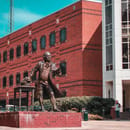April is National Poetry Month! And as such, I feel the need to get something off my chest. I, a proud English major — brace yourself! — am not the biggest fan of reading poetry. I know. Sure, there are particular poems that I love and I have even written poetry myself, but for the most part, I steer clear of this genre when browsing the bookstore. I’m not sure why, but somewhere along the way, my enjoyment of poetry got lost in the frilly stanzas and grandiose metaphors. Nevertheless, I think it’s finally time that I put my lackluster feelings aside and start appreciating the art of poetry again.
As an English major, I read countless works of poetry every semester, but very rarely do I actually put faces to the names below the title. So, in the spirit of National Poetry Month, I’d like to get to know some of the most famous names in poetry a little better. As such, I’ve comprised the following list of obscure facts that you probably don’t know about your favorite poets (or at least, the poets you call your favorite to seem more cultured).
1. Robert Frost (1874-1963)
Most famous works: “The Road Not Taken,” “Stopping By Woods on a Snowy Evening,” and “Fire and Ice”
A little-known fact: You might know Robert Frost’s name to be synonymous with poetry, but did you know that he was valedictorian of his high school class? Frost excelled in school and when he graduated in 1892, he was named co-valedictorian alongside his future wife, Elinor White.
2. Shel Silverstein (1930-1999)
Most famous works: “Where the Sidewalk Ends,” “A Light in the Attic,” and “The Giving Tree”
A little-known fact: Shel Silverstein was a poet, children’s author and a Grammy award winner. Silverstein penned the popular Johnny Cash song, “A Boy Named Sue,” and ended up taking home the Grammy for Best Country Song in 1969.
3. Maya Angelou (1928-2014)
Most famous works: “I Know Why the Caged Bird Sings,” “On the Pulse of Morning,” and “Still I Rise”
A little-known fact: Maya Angelou certainly had a way with words, and this might have something to do with the fact that she was multilingual. Angelou was fluent in six languages and over the course of her life, learned French, Italian, Spanish, Hebrew and Fante.
4. Edgar Allan Poe (1809-1849)
Most famous works: “The Tell-Tale Heart,” “The Raven,” and “Annabel Lee”
A little-known fact: Although you might imagine that Edgar Allan Poe was at one point the 19th-century iteration of a goth teenager, this was not entirely the case. In his younger years, Poe was described as athletic and attractive to those who knew him. At only the age of fifteen, he even achieved a local record by swimming six miles up the James River.
5. Oscar Wilde (1854-1900)
Most famous works: “The Picture of Dorian Gray,” “The Importance of Being Earnest,” and “The Ballad of Reading Gaol”
A little-known fact: Did you know that the popular saying, “be yourself, everyone else is taken,” is largely believed to have first been uttered by Oscar Wilde? Although this is a common belief, there is no concrete evidence that supports this phrase originating from Wilde.
6. Emily Dickinson (1830-1886)
Most famous works: “‘Hope’ is the thing with feathers,” “Because I could not stop for Death,” and “I’m Nobody! Who are you?”
A little-known fact: In addition to poetry, Emily Dickinson was also very passionate about gardening. Not only did the Dickinson family property include a fully-functioning greenhouse but Dickinson also planted hundreds of plants on the grounds. According to the Emily Dickinson Museum, her garden was complete with flowers, vegetables, and various fruit trees.
7. Langston Hughes (1902-1967)
Most famous works: “Harlem,” “The Weary Blues,” and “I, Too”
A little-known fact: Despite Langston Hughes’ gift for writing, he initially pursued a degree in engineering at Columbia University. Hughes eventually dropped out of the program after a year and later received an English degree from Lincoln University. Thurgood Marshall was one of his classmates.
8. John Keats (1795-1821)
Most famous works: “Bright star, would I were stedfast as thou art,” “To Autumn,” and “On Seeing the Elgin Marbles”
A little-known fact: John Keats is considered to be one of the most influential voices in literary history. Despite this fact, Keats was incredibly critical of his own work. So much so, that once he became published, Keats burned every last trace of his earlier works.
9. Sylvia Plath (1932-1963)
Most famous works: “Daddy,” “Mirror,” and “Tulips”
A little-known fact: Sylvia Plath’s intelligence is immediately apparent upon reading her work, but Plath was also considered a genius by the standard IQ scale. When she was twelve-years-old, her IQ was estimated to be around 160. The standard IQ scale places a genius at 140 and above.
10. Lord Byron (1788-1824)
Most famous works: “Don Juan,” “She Walks in Beauty,” and “Childe Harold’s Pilgrimage”
A little-known fact: Lord Byron was close friends with Percy and Mary Shelley. In the summer of 1816, they accompanied Byron on a trip to Switzerland. During the trip, Byron challenged his group of companions to write their best horror story. In response, Mary Shelley composed her famous novel, “Frankenstein.”
Happy National Poetry Month, collegiettes!



